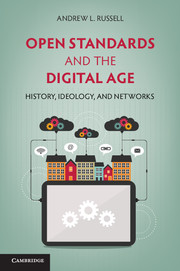Book contents
- Frontmatter
- Dedication
- Contents
- Tables and Figures
- Acknowledgments
- List of acronyms
- 1 Introduction
- 2 Ideological Origins of Open Standards I: Telegraph and Engineering Standards, 1860s–1900s
- 3 Ideological Origins of Open Standards II: American Standards, 1910s–1930s
- 4 Standardization and the Monopoly Bell System, 1880s–1930s
- 5 Critiques of Centralized Control, 1930s–1970s
- 6 International Standards for the Convergence of Computers and Communications, 1960s–1970s
- 7 Open Systems and the Limits of Democratic Design, 1970s–1980s
- 8 The Internet and the Advantages of Autocratic Design, 1970s–1990s
- 9 Conclusion
- Bibliography
- Index
- References
3 - Ideological Origins of Open Standards II: American Standards, 1910s–1930s
Published online by Cambridge University Press: 05 June 2014
- Frontmatter
- Dedication
- Contents
- Tables and Figures
- Acknowledgments
- List of acronyms
- 1 Introduction
- 2 Ideological Origins of Open Standards I: Telegraph and Engineering Standards, 1860s–1900s
- 3 Ideological Origins of Open Standards II: American Standards, 1910s–1930s
- 4 Standardization and the Monopoly Bell System, 1880s–1930s
- 5 Critiques of Centralized Control, 1930s–1970s
- 6 International Standards for the Convergence of Computers and Communications, 1960s–1970s
- 7 Open Systems and the Limits of Democratic Design, 1970s–1980s
- 8 The Internet and the Advantages of Autocratic Design, 1970s–1990s
- 9 Conclusion
- Bibliography
- Index
- References
Summary
We do not leave to Congress, or to the vote of 110,000,000 people, the decision whether a bridge shall be built in the city of Oshkosh. We leave it to the people of Oshkosh, who will walk over it and ride over it, and who will have to pay for it. Why should not the very limited groups directly interested in each of the innumerable industrial problems with which they are faced, themselves solve these problems through coöperative effort?
– Paul Gough Agnew “A Step Toward Industrial Self-Government,” 1926In the late afternoon of June 15, 1922, Herbert Hoover dropped in to a meeting of forty-four engineers who had assembled in a conference room at his Department of Commerce in Washington, D.C. Hoover, who earned international fame as the “Great Humanitarian” by guiding relief efforts during World War I, turned his talents and energies toward the American economy when he was named secretary of commerce by Warren Harding in 1921. Hoover was, in the pre-Depression era, a living and breathing icon of the triumph of rationality, organization, and the progressive spirit of the engineering profession – the “engineering method personified” in the words of one admiring colleague.
Several of Hoover’s contemporaries – such as the social theorist Thorstein Veblen and the radical engineers Howard Scott and Morris Cooke – believed that technical expertise could reform society and engineer a new age of efficiency and abundance. But the meeting at the Department of Commerce was not some sort of revolutionary “Soviet of Technicians.” Instead, it was a meeting of the leaders of the American Engineering Standards Committee (AESC), a private group of engineers who had a more modest and pragmatic goal: to order the inconsistent patchwork of codes, tests, and standards used in American industrial practice. Although the AESC sought (and found) support from Hoover and other government officials, their method of work – consistent with the American mentality that Tocqueville observed in the mid-nineteenth century – depended on private cooperation to create standards that would, in turn, be adopted on a voluntary basis throughout American industry. Unlike their peers abroad, they did not depend on kings (Tocqueville’s “men of rank”) or presidents (“men of government”). Instead, their success would hinge on their ability to convince industrial managers and executives that industry standards would make business less wasteful and more profitable.
- Type
- Chapter
- Information
- Open Standards and the Digital AgeHistory, Ideology, and Networks, pp. 58 - 94Publisher: Cambridge University PressPrint publication year: 2014

